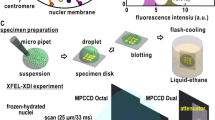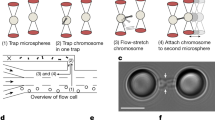Abstract
IN a recent article in these columns1 and in a paper presented to the Royal Microscopical Society on February 20, 19352, I put forward a model of a chromosome as an aggregate of polypeptide protamine molecules in association with nucleic acid. It is unfortunate that data of a physico-chemical nature by means of which this hypothesis can be tested and rendered more precise are at present very meagre. It is, therefore, specially important to make the fullest use of such facts as are available, and in particular of those relating to the variable geometrical configurations of chromosomes, which are of the highest degree of delicacy and reliability3,4. These are of particular importance in view of the recent work on the giant chromosomes in the salivary glands of Drosophila, Chironomus and Sciara5. I have, therefore, undertaken a systematic survey of these data and wish, in this preliminary announcement, to direct the attention of cytologists to the various contractile factors which the chromosome micelle may be expected to possess.
This is a preview of subscription content, access via your institution
Access options
Subscribe to this journal
Receive 51 print issues and online access
$199.00 per year
only $3.90 per issue
Buy this article
- Purchase on Springer Link
- Instant access to full article PDF
Prices may be subject to local taxes which are calculated during checkout
Similar content being viewed by others
References
NATURE, 134, 978, December 22, 1934.
“Chromosomes and their Structure”. (In course of publication in the J. Roy. Micro. Soc.)
C. D. Darlington, “Recent Advances in Cytology”. London, 1932. Y. Kuwada and T. Nakamura, Mem. Coll. Sci., Kyoto, 9, 129–139; 1933. Y. Kuwada and T. Nakamura, ibid., 9, 343–366; 1934. N. Shinke, ibid., 9, 367–392; 1934. P. Ch. Koller and C. D. Darlington, J. Genet., 29, 159–173; 1934.
C. D. Darlington, Cytologia, 4, 229–240; 1933.
T. S. Painter, J. Hered., 25, 465–476; 1934. C. W. Metz and E. H. Gay, Proc. Nat. Acad. Sci., 30, 617–621; 1934. R. L. King and H. W. Beams, J. Morph., 56, 577–588; 1934. H. J. Muller and A. Prokofieva, Comptes Rendus de l'Acad. des Sciences de l'U.R.S.S., 4, 74–83, October 11, 1934. P. Ch. Koller, NATURE, 135, 69, January 12, 1935.
Reference should be made to the literature of the zwitterion, specially to L. J. Harris, Biochem. J., 24, 1080–1097; 1930.
W. T. Astbury and H. J. Woods, Phil. Trans. Roy. Soc., A, 232, 333–394; 1933. W. T. Astbury “Fundamentals of Fibre Structure”. Oxford, 1933.
P. A. Levene and L. W. Bass, “Nucleic Acids”, New York, 1932.
D. Jordan Lloyd, J. Int. Soc. of Leather Trades' Chemists, 245–258; 1933.
W. T. Astbury, NATURE, 135, 95, Jan. 19, 1935.
D. Jordan Lloyd, Biol. Rev., 7, 254–273; 1932.
A. Stanberry and B. Byerley, J. Text. Inst., 295T, 1934.
Author information
Authors and Affiliations
Rights and permissions
About this article
Cite this article
WRINCH, D. The Contractile Factors of the Chromosome Micelle. Nature 135, 788–789 (1935). https://doi.org/10.1038/135788b0
Issue Date:
DOI: https://doi.org/10.1038/135788b0
This article is cited by
-
The fabric structure oe proteins with special reference to cytogenetics
Journal of Genetics (1940)
-
�ber den Aufbau der Eiwei�molek�le
Kolloid-Zeitschrift (1937)
-
Beobachtungen an Chromosomen im Dunkelfeld und im ultravioletten Licht
Mikrochemie (1936)
-
On the molecular structure of chromosomes
Protoplasma (1936)
-
The Chromosome Micelle and the Banded Structure of Chromosomes in the Salivary Gland
Nature (1935)
Comments
By submitting a comment you agree to abide by our Terms and Community Guidelines. If you find something abusive or that does not comply with our terms or guidelines please flag it as inappropriate.



